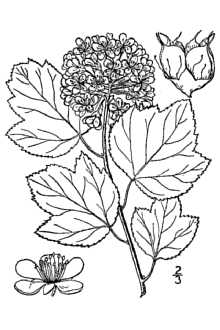Common Ninebark
Scientific Name: Physocarpus opulifolius (L.) Maxim. var. opulifolius

| General Information | |
|---|---|
| Usda Symbol | PHOPO |
| Group | Dicot |
| Life Cycle | Perennial |
| Growth Habits | Shrub |
| Native Locations | PHOPO |
Plant Guide
Uses
Atlantic ninebark is cultivated in the US and in Europe for its foliage, clusters of white flowers in the spring, and red fruits in the autumn. Various cultivars have been selected for compactness of growth, yellow or golden leaf color, and greater size and showiness of flower clusters. Flowers of Atlantic ninebark are an excellent nectar source, and the fruits are eaten by many species of birds. Physocarpus monogynus of the southwestern US, was used by Indians to relieve pain – the roots were boiled to softness and placed on sores and lesions as a poultice.
Status
Please consult the PLANTS Web site and your State Department of Natural Resources for this plant’s current status, such as, state noxious status and wetland indicator values.
Description
General: Rose Family (Rosaceae), Native shrubs growing 1-3 meters tall, sometimes tree-like, with wide-spreading, recurved branches, the twigs brown to yellowish, glabrous; bark brown to orangish, peeling into thin strips or broader sheets on larger trunks, Leaves are deciduous, alternate, simple, ovate to obovate or nearly round, 3-12 cm long, with 3(-5) shallow, palmate-veined lobes, basally truncate or cuneate, on petioles 1-3 cm long, glabrous above and mostly so beneath but sometimes with a sparse covering of stellate hairs beneath, with crenate or dentate margins, Inflorescence of numerous flowers found in rounded clusters 2,5-5 cm wide; flowers 7-10 mm wide, calyx cup-shaped, glabrous or with stellate hairs, 5-lobed; petals 5, white or pinkish; styles 5; stamens 30-40, Fruit is compressed but inflated, ovoid, 8-12 mm long, shiny, red at maturity, glabrous or hairy, with papery but firm walls, splitting along two sides, in clusters of (2-)3-5 per flower; seeds 2-4, The common name comes from the bark, which continually molts in thin strips, each time exposing a new layer of bark, as if it had “nine lives,” This species flowers in May-July and fruits in May-July, R, Mohlenbrock USDA, NRCS, Wetland Science Institute @ PLANTS Variation within the species: two varieties are sometimes recognized within the species, Var, intermedius (Rydb,) B,L, Use soil moisture sensors to measure the soil moisture of Common Ninebark., Robins, has fruits that are persistently covered with stellate hairs, while var, opulifolius has glabrous fruits, Var, intermedius is the more western form, occurring from New York, Ontario, Ohio, Indiana, Illinois, Missouri, and Arkansas to the westernmost localities for the species, Var, opulifolius is broadly distributed in the east, to Minnesota and Iowa, and in Canada from New Brunswick and Nova Scotia to Manitoba, Intergradation in the fruit character makes it difficult to discern clear distributional boundaries,
Distribution
Atlantic ninebark occurs widely in eastern North America, in Canada from Manitoba to the easternmost provinces, and in the US from Minnesota to Arkansas (with outlying occurrences in Colorado, North Dakota and South Dakota to Oklahoma) and eastward to the Atlantic states. It has not been recorded from Texas, Louisiana, or Mississippi. For current distribution, please consult the Plant Profile page for this species on the PLANTS Web site.
Adaptation
The plants are found on moist soils in thickets, along streams in sand or gravel bars, and on rocky slopes and bluffs. Dirr (1997) observes that “the species is adaptable to all conditions, probably even nuclear attacks, and once established, requires a bulldozer for removal.”
Establishment
Atlantic ninebark can be propagated from cuttings or seeds, which germinate without pre-treatment. It transplants readily and apparently grows easily over a range of light, moisture, and acidity.
Management
Information on fire response is not available for Atlantic ninebark, but shrubs of the western US species Physocarpus malvaceus (Greene) Kuntze readily re-sprout after intense surface burns (Lea & Morgan 1993). Cultivars, Improved and Selected Materials (and area of origin) These plant materials are readily available from commercial sources. Contact your local Natural Resources Conservation Service (formerly Soil Conservation Service) office for more information. Look in the phone book under ”United States Government.” The Natural Resources
Conservation
Service will be listed under the subheading “Department of Agriculture.”
References
Dirr, M.A. 1997. Dirr's hardy trees and shrubs: An illustrated encyclopedia. Timber Press, Portland, Oregon. Kurz, D. 1997. Shrubs and woody vines of Missouri. Missouri Dept. of Conservation, Jefferson City, Missouri. Lea, S.M. & P. Morgan 1993. Resprouting response of ninebark (Physocarpus malvaceus) shrubs to burning and clipping. Forest Ecol. Management. 56:199-210. USDA, NRCS 1993. Northeast wetland flora: Field office guide to plant species. Wetland Science Institute, Laurel, Maryland.
